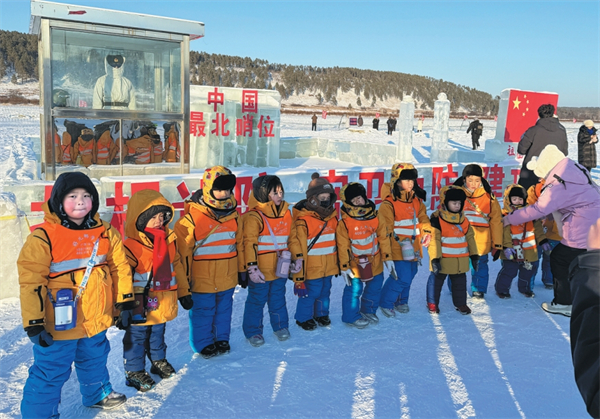Home>Photo Gallery
Ice sculptor is carving out a name for himself
Updated : 2015-01-16
By Zhou Huiying ( China Daily )

Su Shi creates his ice sculpture Survival of the Fittest for the 29th China Harbin International Ice Sculpture Competition. Zhou Huiying / China Daily
Prize-winning artist loves working in the outdoors during freezing weather
The bitter winter weather in Harbin, the capital of Heilongjiang province, may not suit everyone who lives there, but it's perfect for snow and ice artist Su Shi.
"In most parts of China, it's not cold enough to create snow and ice sculpture works outside," he said. "But in Harbin, the frozen Songhua River provides large, high-quality ice blocks, and the cold weather provides abundant snow."
There is snow and ice for more than a third of the year in Northeast China.
"In winter, I often work outdoors for 10 hours a day, but I enjoy every minute," Su added. "I feel lucky that I have the chance to pursue my creativity using ice and snow as a medium for expression."
In 2010, Su set up his own studio to focus on projects nationwide. He has created many snow and ice sculptures in Harbin, and has constructed indoor snow and ice sculpture parks in three cities in Hebei province - Shijiazhuang, Handan and Baoding.
He started to draw at the age of eight.
"When I was a kid, I was fascinated by the craftsmanship of the folk artists drawing on the furniture in my home village of Yichun," he said. "I had to study the technique by myself, as my family could not afford to pay for lessons."
He copied thousands of illustrations from books during his primary school years.
In 1992, Su entered a junior high school where he learned some of the basics of drawing in art class.
However, the school closed in Su's second year because of a shortage of students. Su dropped out of school and became an apprentice at a woodcraft factory, where he learned to carve.
"Knowing the basics of drawing helped me to become skilled at carving wood quickly, but sculpture is different from drawing, it requires more complicated skills and more tools."
In 2003, he moved to Harbin and continued to make a living from carving.
His first foray into snow sculpture came in 2006, when he was asked by a friend to help create a piece for the 19th International Snow Sculpture Art Expo in Harbin.
"By then, I had been sculpting for more than 10 years, but my materials were usually wood or plaster," Su said.
"Snow sculptures tend to be larger than wooden ones, and it was unforgettable to work on a giant snow block for the first time. I had no professional tools for snow sculpture, so I used a kitchen knife, a spatula and a potato peeler."
Before starting work on a sculpture, Su draws the design on paper.
"The ideas for my works usually come from my experiences of life and observations of the world."
His work Survival of the Fittest, which won second prize at the 29th China Harbin International Ice Sculpture Competition, was inspired by an item on the TV news.
"The story was about a leopard that tried to catch and kill a crocodile that was fiercer and much larger than it," Su said.
"As the saying goes, fortune favors the bold. The sculpture reflects the wisdom, bravery and confidence of the leopard by showing it sneaking up on the crocodile."
Su has taken part in more than 10 domestic and international snow and ice sculpture competitions, winning three first prizes and five second prizes.
"It's not about winning," he said. "It's about exchanging ideas and making new friends. Harbin stands for a high standard of snow and ice carving in the global industry, so I feel proud to be a representative of the city.
"Snow and ice carving is not only my job, it's my life."

Harbin ramps up childcare services
A new comprehensive service center for childcare in Harbin is expected to be finished by the end of the year.
-
Talent policies drive enterprise development in Harbin
Harbin's "30 New Talent Policies" represents an iterative upgrade to the talent policy system, helping attract and retain talent to bolster economic and social development.
-
Official website of 2025 Asian Winter Games goes live
Harbin, the host city of the 9th Asian Winter Games, has announced that the official website for the 2025 event has recently gone live.
-
Harbin launches measures to facilitate more foreign trade
In the first three quarters of 2023, the total import and export value of Heilongjiang province's goods trade hit 218.22 billion yuan.





